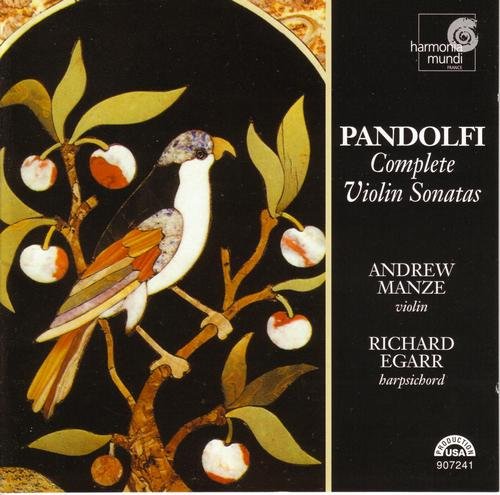
Andrew Manze, Richard Egarr - Pandolfi: Complete Violin Sonatas (1999)
BAND/ARTIST: Andrew Manze, Richard Egarr
- Title: Pandolfi: Complete Violin Sonatas
- Year Of Release: 1999
- Label: Harmonia Mundi
- Genre: Classical
- Quality: FLAC (tracks)
- Total Time: 80:00
- Total Size: 488 Mb
- WebSite: Album Preview
Tracklist:
Opus 3 (1660)
1. N. 1, 'La Stella' - 3:56
2. N. 2, 'La Cesta' - 7:15
3. N. 3, 'La Melana' - 5:38
4. N. 4, 'La Castella' - 7:27
5. N. 5, 'La Clemente' - 8:01
6. N. 6, 'La Sabbatina' - 7:32
Opus 4 (1660)
7. N. 1, 'La Bernabea' - 8:12
8. N. 2, 'La Viviana' - 5:47
9. N. 3, 'La Monella Romanesca' - 6:33
10. N. 4, 'La Biancuccia' - 7:03
11. N. 5, 'La Stella' - 4:51
12. N. 6, 'La Vinciolina' - 7:19
Performers:
Andrew Manze – violin
Richard Egarr – harpsichord
Opus 3 (1660)
1. N. 1, 'La Stella' - 3:56
2. N. 2, 'La Cesta' - 7:15
3. N. 3, 'La Melana' - 5:38
4. N. 4, 'La Castella' - 7:27
5. N. 5, 'La Clemente' - 8:01
6. N. 6, 'La Sabbatina' - 7:32
Opus 4 (1660)
7. N. 1, 'La Bernabea' - 8:12
8. N. 2, 'La Viviana' - 5:47
9. N. 3, 'La Monella Romanesca' - 6:33
10. N. 4, 'La Biancuccia' - 7:03
11. N. 5, 'La Stella' - 4:51
12. N. 6, 'La Vinciolina' - 7:19
Performers:
Andrew Manze – violin
Richard Egarr – harpsichord
Giovanni Antonio Pandolfi briefly surfaced at the Hapsburg court in Innsbruck in 1660 with the pair of violin publications performed here. Little is known of his life beyond what can be gleaned from the dedications and other matter associated with these two sets of sonatas for violin and continuo, and the downright bizarre quality of the music only heightens the air of mystery. British historical-performance specialist Andrew Manze, who has a very pleasing touch in the so-called stylus phantasticus of fantastic style of the later seventeenth century, writes in the notes that Pandolfi might be considered the "godfather" of the virtuoso violin tradition in the German sphere running from Biber down to the mighty unaccompanied sonatas and partitas of J.S. Bach. The problem with this is that Pandolfi's sonatas do not sound much like Biber, even at his most experimental, or anyone else. Their nearest relatives are the works of Marco Uccellini, who may have been influenced by Pandolfi. If your tastes run to the extreme in the music of the seventeenth century, rest assured that it doesn't come much more extreme than this. Pandolfi's sonatas consist, in the seventeenth century manner, of alternating and loosely connected slow and fast sections, but the emphasis is decidedly on the former and on the unearthly effects that the player, aided to some extent by his or her own improvisatory imagination, can bring to the fore. Many of the sonatas end with the slow music, and some break off with a kind of perfunctory gesture, matching the conventional openings that Manze compares to chess openings: they start calmly and then quite suddenly become entirely individual. What happens then varies from piece to piece, and is not so much blisteringly virtuosic (although there are instances of that) as radical. Pandolfi favors an effect in which dissonances and repeated notes are threaded through long chains of double stops, and he offers quasi-antiphonal passages and other devices that suggest a formidable stage personality. Sample the second sonata of Op. 3, "La Cesta" (track 2), to get an idea of the thrill ride effect, which is so pronounced that Manze suggests, quite rightly, that the sonatas are best enjoyed in ones and pairs. With the whole disc clocking in at exactly 80 minutes, that offers the listener many sessions of remarkable music.
DOWNLOAD FROM ISRA.CLOUD
Andrew Manze Richard Egarr Pandolfi Complete Violin Sonatas 99 1802.rar - 488.7 MB
Andrew Manze Richard Egarr Pandolfi Complete Violin Sonatas 99 1802.rar - 488.7 MB
As a ISRA.CLOUD's PREMIUM member you will have the following benefits:
- Unlimited high speed downloads
- Download directly without waiting time
- Unlimited parallel downloads
- Support for download accelerators
- No advertising
- Resume broken downloads


